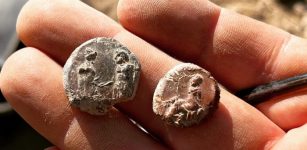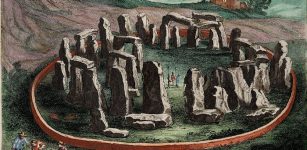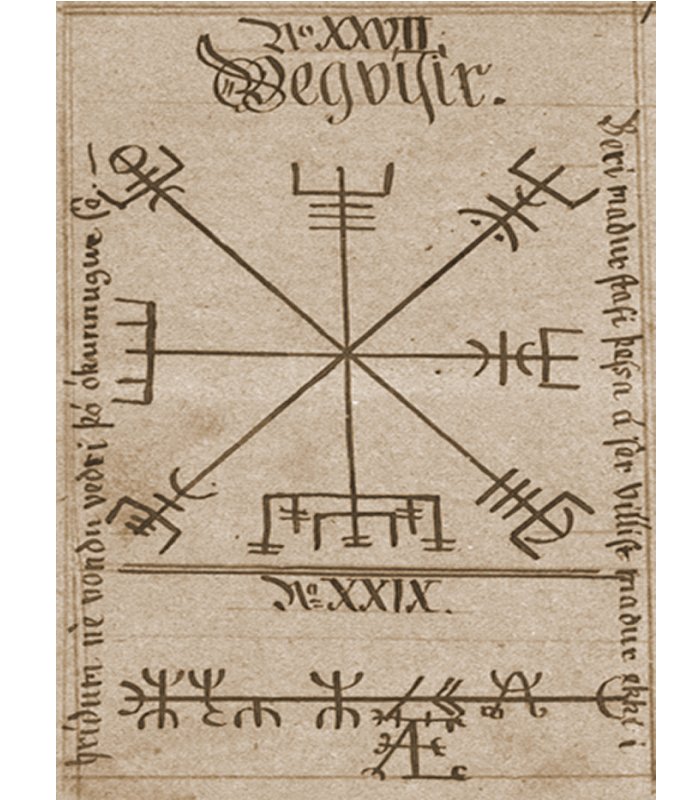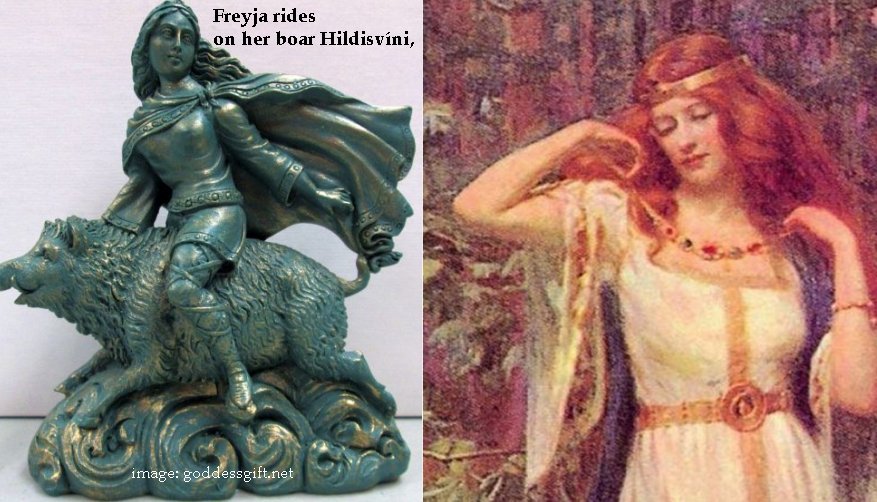Vegvisir – Old, Sacred Norse Symbol Of Protection And Guidance
A. Sutherland - AncientPages.com - Vegvisir is among the oldest and sacred Norse symbols, and it initially originated in Iceland, where 'Vegur' means - road or path and 'Vísir' means – Guide.
Vegvisir from Geir Vigfússon's work - Huld Manuscript. It was a kind of runic compass with rune script used by ancient Icelandic Vikings. (National and University Library of Iceland)
The symbol was frequently inscribed on seagoing vessels to ensure their safe return home.
The device was believed to show the way back home and protect seamen and their ships from storms. The Vegvisir was like a guide helping its bearer to find his way home. Norse people believed that the Vegvisir had special powers; therefore, it was treated as a talisman for luck, protection, and blessings. This powerful symbol could help a person to find the right way in storms or bad weather, whatever unfamiliar surroundings they may encounter.
As a spiritual compass, this magical device guides your heart and steps to make the right choices in life. It has also long played an essential role among people who believe in magic powers, such as Norse Shamans. If you have lost yourself and your faith, this sacred symbol helps you find confidence again.
A Völva in Norse mythology predicted the future. Read more
'Saga of Hrana hrings' (Hrana Saga Circle) is one of the Sagas of Icelanders, existing only in manuscripts dated back to 1887-1888. It mentions the Vegvisir: "…the weather was cloudy and stormy ….the king looked around and did not see the blue sky… then the king took the vegvisir in his hands and saw where [the sun] appeared on the stone…. "
The symbol appears in an Icelandic book of magic, or grimoire, known by Galdrabók, published around 1600 AD. Also, in 1860, in the 'Huld Manuscript,' Geir Vigfusson mentions the Vegvisir. Vigfusson collected and categorized various Icelandic folk symbols using some much older material.
A leaf of the manuscript provides an image of the vegvísir, gives its name, and, in prose, declares that "if this sign is carried, one will never lose one's way in storms or bad weather, even when the way is not known…"
Did you know that the Norse Goddess Freya was the most prominent völva? Learn more
Viking and Norse symbols represented gods, beliefs, and myths. Some Viking symbols remain mysterious, and their meaning is still unknown, but there are also many ancient symbols that have clear messages.
Norse shamans such as the powerful, mighty Völva, whom even Norse gods feared, depended on her magical staff to foretell the future. The usage of symbols for communication or divination played an essential role among Norse Shamans.
Some suggest that the Vegvisir was created by the Ásatrú, who believe in ancient Germanic spirits and Gods, but this statement is false. Ásatrú is a New Age movement, and the Vegvisir is an ancient symbol used in ancient times.
The true power of the Vegvisir is hidden in each of its eight staves, offering different protection against many obstacles that might cause one to lose one's way.
The Vegvisir remains a unique, mysterious Norse symbol of unknown age. It's a powerful ancestral spiritual symbol that survives to this day. Tattoos and amulets made in the image of a Vegvisir are common today.
Written by A. Sutherland – AncientPages.com Staff Writer
Updated on November 27, 2022
Copyright © AncientPages.com All rights reserved. This material may not be published, broadcast, rewritten or redistributed in whole or part without the express written permission of AncientPages.com
Expand for referencesMore From Ancient Pages
-
 Strange Desert Castle Qasr Kharana In Jordan
Featured Stories | Oct 1, 2019
Strange Desert Castle Qasr Kharana In Jordan
Featured Stories | Oct 1, 2019 -
 More Than 2,000 Seal Impressions Found In The Ancient City Of Doliche
Archaeology | Nov 24, 2023
More Than 2,000 Seal Impressions Found In The Ancient City Of Doliche
Archaeology | Nov 24, 2023 -
 Mysterious Ancient Dark Object Hidden In The Colorado Mountains – What Happened To It?
Featured Stories | Jun 17, 2024
Mysterious Ancient Dark Object Hidden In The Colorado Mountains – What Happened To It?
Featured Stories | Jun 17, 2024 -
 Ancestor Of Italian Pizza Depicted On Fresco In Pompeii
Archaeology | Jun 28, 2023
Ancestor Of Italian Pizza Depicted On Fresco In Pompeii
Archaeology | Jun 28, 2023 -
 Face Of Neanderthal Who Lived 56,000 Years Ago Reconstructed
Archaeology | Nov 10, 2023
Face Of Neanderthal Who Lived 56,000 Years Ago Reconstructed
Archaeology | Nov 10, 2023 -
 Ancient Mysteries Of Wisconsin – Great Forgotten Prehistoric Events Shed New Light On History Of North America
Ancient Mysteries | Jan 11, 2019
Ancient Mysteries Of Wisconsin – Great Forgotten Prehistoric Events Shed New Light On History Of North America
Ancient Mysteries | Jan 11, 2019 -
 Mythical Danaides: Daughters Of Danaus Condemned In Hades To Eternal Punishment
Featured Stories | Mar 22, 2016
Mythical Danaides: Daughters Of Danaus Condemned In Hades To Eternal Punishment
Featured Stories | Mar 22, 2016 -
 Hunter-Gatherers Used Open Habitats Millennia Before Stonehenge Monuments Were Built
Archaeology | Apr 27, 2022
Hunter-Gatherers Used Open Habitats Millennia Before Stonehenge Monuments Were Built
Archaeology | Apr 27, 2022 -
 Ancient Ruins Of Kilwa Kisiwani And Songo Mnara: Great African Ports Long Abandoned And Forgotten
Civilizations | Nov 21, 2018
Ancient Ruins Of Kilwa Kisiwani And Songo Mnara: Great African Ports Long Abandoned And Forgotten
Civilizations | Nov 21, 2018 -
 Excavations At Okazaki Castle Reveal A 400-Year-Old Massive Unbroken Wall
Archaeology | Apr 16, 2016
Excavations At Okazaki Castle Reveal A 400-Year-Old Massive Unbroken Wall
Archaeology | Apr 16, 2016 -
 Effects Of The Volcanic Eruption In Alaska Rippled Through Ancient Egypt During Cleopatra’s Reign
Archaeology | Jul 26, 2022
Effects Of The Volcanic Eruption In Alaska Rippled Through Ancient Egypt During Cleopatra’s Reign
Archaeology | Jul 26, 2022 -
 On This Day In History: Terracotta Army Buried With Emperor Qin Shi Huang Discovered – On Mar 29, 1974
News | Mar 29, 2017
On This Day In History: Terracotta Army Buried With Emperor Qin Shi Huang Discovered – On Mar 29, 1974
News | Mar 29, 2017 -
 On This Day In History: Battle Of Naulochus Was Fought Off The Coast Of Sicily – On Sep 3, 36 BC
News | Sep 3, 2015
On This Day In History: Battle Of Naulochus Was Fought Off The Coast Of Sicily – On Sep 3, 36 BC
News | Sep 3, 2015 -
 Pax Romana: 200-Year-Long Period Of Stability Within The Roman Empire
Ancient History Facts | Apr 19, 2016
Pax Romana: 200-Year-Long Period Of Stability Within The Roman Empire
Ancient History Facts | Apr 19, 2016 -
 Can You Solve The Mystery Of The Nessglyph? Archaeologists Ask
Archaeology | Jan 31, 2023
Can You Solve The Mystery Of The Nessglyph? Archaeologists Ask
Archaeology | Jan 31, 2023 -
 Magnificent 2,000-Year-Old Treasure Found In Wales Could Point To An Unknown Roman Settlement
Archaeology | May 12, 2023
Magnificent 2,000-Year-Old Treasure Found In Wales Could Point To An Unknown Roman Settlement
Archaeology | May 12, 2023 -
 Disappearance Of Neanderthals: Were Inbreeding And Demographic Shifts Responsible?
Archaeology | Nov 28, 2019
Disappearance Of Neanderthals: Were Inbreeding And Demographic Shifts Responsible?
Archaeology | Nov 28, 2019 -
 Mystery Of The Hidden Wooden Hieroglyphic Tablets And The Unknown White Bearded Men – The Vatican – Part 1
Featured Stories | Mar 2, 2021
Mystery Of The Hidden Wooden Hieroglyphic Tablets And The Unknown White Bearded Men – The Vatican – Part 1
Featured Stories | Mar 2, 2021 -
 Identity Of Anti-Christ And Number 666 Revealed By Ancient History Professor
Archaeology | Apr 6, 2019
Identity Of Anti-Christ And Number 666 Revealed By Ancient History Professor
Archaeology | Apr 6, 2019 -
 Genetic Fingerprints Of Unknown Species Discovered In Human DNA
Human Beginnings | Dec 31, 2019
Genetic Fingerprints Of Unknown Species Discovered In Human DNA
Human Beginnings | Dec 31, 2019



